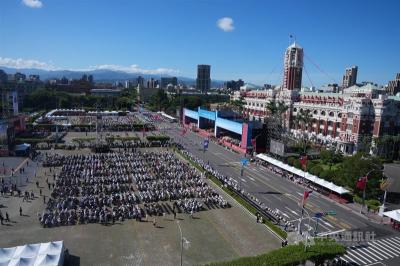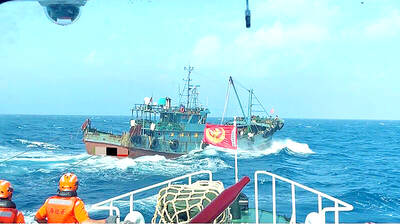Japan is considering building its own fighter jets after years of playing second fiddle in a US construction partnership, a report said yesterday, in a move likely to stoke fears of its military resurgence among Asian neighbors.
Japan’s attempt in the 1980s to build its first purely domestic fighters since World War II faced US resistance and resulted in joint US-Japanese development and production of the F-2, the Nikkei Shimbun said.
However, joint F-2 production ended more than two years ago and the last of the fighters are due to be retired from Japan’s air defense force in about 2028, it added.
The Japanese Ministry of Defense plans to seek about ¥40 billion (US$387 million) in state funding for the next fiscal year, which starts in April next year, to test experimental engines and radar-dodging stealth airframe designs for a purely Japanese fighter, the report said.
According to its medium-term defense program, the Tokyo government will decide by the 2018 financial year whether to go ahead with the all-Japanese fighter project.
There is a growing need for Japan to develop a long-haul, highly stealthy fighter jet in the face of China’s increasing assertiveness in the East China Sea, where the two countries are locked in a dispute over a group of Tokyo-controlled islands, the Nikkei said.
Last month, Japanese Prime Minister Shinzo Abe’s Cabinet proclaimed the right to go into battle in defense of allies — in a highly controversial shift in the nation’s post-war pacifist stance.
Japan denies its intent is anything other than defensive.
The defense ministry started work four years ago on the so-called Advanced Technology Demonstrator-X (ATD-X) plane to explore the project’s feasibility by studying lightweight airframe designs and built-in missile-firing mechanisms, the Nikkei said.
Japan is is due to start testing experimental engines for the ATD-X in January next year and the stealth airframe designs in April, the report said.
The ministry hopes to develop the actual engines for the project in cooperation with IHI, Mitsubishi Heavy and other defense contractors in about five years.
Developing a purely domestic fighter is estimated to cost a ¥500 billion to ¥800 billion, the report said.

POLITICAL AGENDA: Beijing’s cross-strait Mid-Autumn Festival events are part of a ‘cultural united front’ aimed at promoting unification with Taiwan, academics said Local authorities in China have been inviting Taiwanese to participate in cross-strait Mid-Autumn Festival celebrations centered around ideals of “family and nation,” a move Taiwanese academics said politicizes the holiday to promote the idea of “one family” across the Taiwan Strait. Sources said that China’s Fujian Provincial Government is organizing about 20 cross-strait-themed events in cities including Quanzhou, Nanping, Sanming and Zhangzhou. In Zhangzhou, a festival scheduled for Wednesday is to showcase Minnan-language songs and budaixi (布袋戲) glove puppetry to highlight cultural similarities between Taiwan and the region. Elsewhere, Jiangsu Province is hosting more than 10 similar celebrations in Taizhou, Changzhou, Suzhou,

The Republic of China (ROC) is celebrating its 114th Double Ten National Day today, featuring military parades and a variety of performances and speeches in front of the Presidential Office in Taipei. The Taiwan Taiko Association opened the celebrations with a 100-drummer performance, including young percussionists. As per tradition, an air force Mirage 2000 fighter jet flew over the Presidential Office as a part of the performance. The Honor Guards of the ROC and its marching band also heralded in a military parade. Students from Taichung's Shin Min High School then followed with a colorful performance using floral imagery to represent Taiwan's alternate name

COGNITIVE WARFARE: Chinese fishing boats transmitting fake identification signals are meant to test Taiwan’s responses to different kinds of perceived incursions, a report said Chinese vessels are transmitting fake signals in Taiwan’s waters as a form of cognitive warfare, testing Taipei’s responses to various types of incursions, a report by the Institute for the Study of War said on Friday. Several Chinese fishing vessels transmitted fake automatic identification system (AIS) signals in Taiwan’s waters last month, with one mimicking a Russian warship and another impersonating a Chinese law enforcement vessel, the report said. Citing data from Starboard Maritime Intelligence, the report said that throughout August and last month, the Chinese fishing boat Minshiyu 06718 (閩獅漁06718) sailed through the Taiwan Strait while intermittently transmitting its own AIS

CHINESE INFILTRATION: Medical logistics is a lifeline during wartime and the reported CCP links of a major logistics company present a national security threat, an expert said The government would bolster its security check system to prevent China from infiltrating the nation’s medical cold chain, a national security official said yesterday. The official, who wished to stay anonymous, made the remarks after the Chinese-language magazine Mirror Media (鏡周刊) reported that Pharma Logistics (嘉里醫藥物流) is in charge of the medical logistics of about half of the nation’s major hospitals, including National Taiwan University Hospital and Taipei Veterans General Hospital. The company’s parent, Kerry TJ Logistics Co (嘉里大榮物流), is associated with the National Committee of the Chinese People’s Political Consultative Conference (CPPCC) and the Chinese People’s Liberation Army (PLA), the